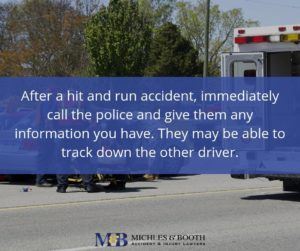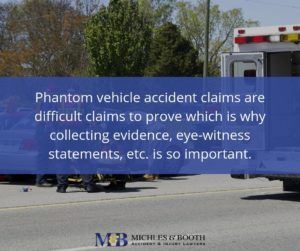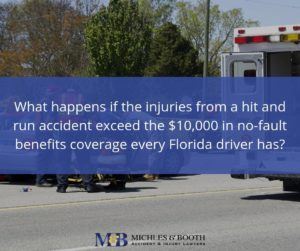Hit and run accidents are where the driver of the vehicle that hit you either jumps out of the car and leaves the scene or drives off leaving the scene of the accident and leaving you injured.
You’re injured, your car is injured, and the other driver’s nowhere to be found. In those circumstances, there are two very important things you should do to ensure that your rights are protected and the evidence at the scene is corroborated so that you can help prove your case.
Contact Law Enforcement Immediately!
You want to call the police immediately, let them know that you were hit by a driver who fled the scene.

Give them as much information as you can about the vehicle that hit you and the driver that hit you. You want to do all those things while the evidence is still fresh in your mind.
The advantage to doing this early is that you can get law enforcement looking for the driver of the vehicle that hit you or that vehicle itself, but more importantly, you can get them to the scene quickly.
If there are other witnesses that are around that are willing to stay, understanding that sometimes that can be difficult as it can sometimes take the police 30 minutes to an hour or even longer to get to the scene of an accident depending on how many other crashes there are or how busy they are. You want to try to have those people stay as well.
It’s important that you wait for the police to get there so that you can get a report that’s proof that you were involved in an accident.
That’s going to be crucial when it comes time to reporting this accident to your insurance company or if you have to bring a claim, helping to substantiate the claim.
Once law enforcement arrives and you give them the information that you have, hopefully, they can try to locate the other driver, but that’s not always successful. Shouldn’t stop you, though. It’s very, very important that you make sure you get a police report.
Contact Your Insurance Company As Soon As Possible
There’s a couple of very important reasons why.
Phantom Vehicle Accidents
If you’re involved in an accident where the other vehicle, let’s say they pull out in front of you or they pull into your lane, but the accident involves you swerving to avoid or crashing because of a vehicle that doesn’t hit you.

Sometimes, your insurance policy may have specific requirements that they expect in order to provide you with any type of coverage because in that case, it’s what could be described as a, quote, “phantom vehicle.”
There’s no evidence that a vehicle collided with you. There’s no evidence that a vehicle caused you to crash. In other words, it’s your word versus the phantom vehicle that’s not there. Contact your insurance right away ensures that you’re complying with all the terms of your insurance policy.
Collecting Information For The Claim
You’ll also want to contact your insurance because they may want to send out somebody to look at the vehicle right away, but they may also want to take a statement right away. Again, in cases involving an accident where the other driver flees the scene, you want to make sure that you don’t jeopardize your coverage under your policy.
Now, when you contact your insurance company and you let them know that you were involved in an accident where the other vehicle fled the scene, you’re going to be looking to make a claim under your collision coverage for the damage to your vehicle, and your no-fault coverage to pay your medical bills.

If your injuries exceed the amount of coverage for no-fault benefits, which here in Florida is $10,000, you’ll be looking to make a claim against your uninsured motorist coverage, your UM coverage. We talk about that in other blog posts.
It’s probably the most important coverage you can have to protect yourself or loved ones, family members, or anybody who’s occupying your vehicle if you’re involved in an accident with a hit and run driver or a phantom vehicle.
Pursuing a personal injury claim.
Now, once you’ve contacted law enforcement and you’ve contacted your insurance to open up a claim, you’ve cooperated with the investigators, there’s still hope that the police can find the vehicle that hit you. In those circumstances, you can still bring a claim against that person’s insurance because although they fled the scene, that in and of itself, is not enough to jeopardize their insurance coverage.
There are increase risk though that if the vehicle that fled the scene was driven by somebody other than the person who owns it, that owner may try to argue, possibly rightly so, that the vehicle was stolen or that the person who drove it and then fled the scene didn’t have permission to drive it.
Other times, you may find the vehicle and find out who owns it, and it may turn out that they sold the vehicle or they have no idea who was driving in.
In all of those circumstances, it may be that the vehicle owner, even if they do locate that person, they may not have any insurance coverage to protect you, and you’d be looking again back at your policy for uninsured motorist coverage.
If you, a friend, loved one has been involved in a car accident where the other driver fled the scene, even if you haven’t been able to find that person, you may still have the ability to bring a claim both for the damage to your car as well as your own injuries. Our personal injury lawyers at Michles & Booth can help you assess your case and decide on how to proceed.
Call us today for a free consultation – (800) 848-6168.
-copy-6[1].jpg)
[1].jpg)
-copy-4[1].jpg)